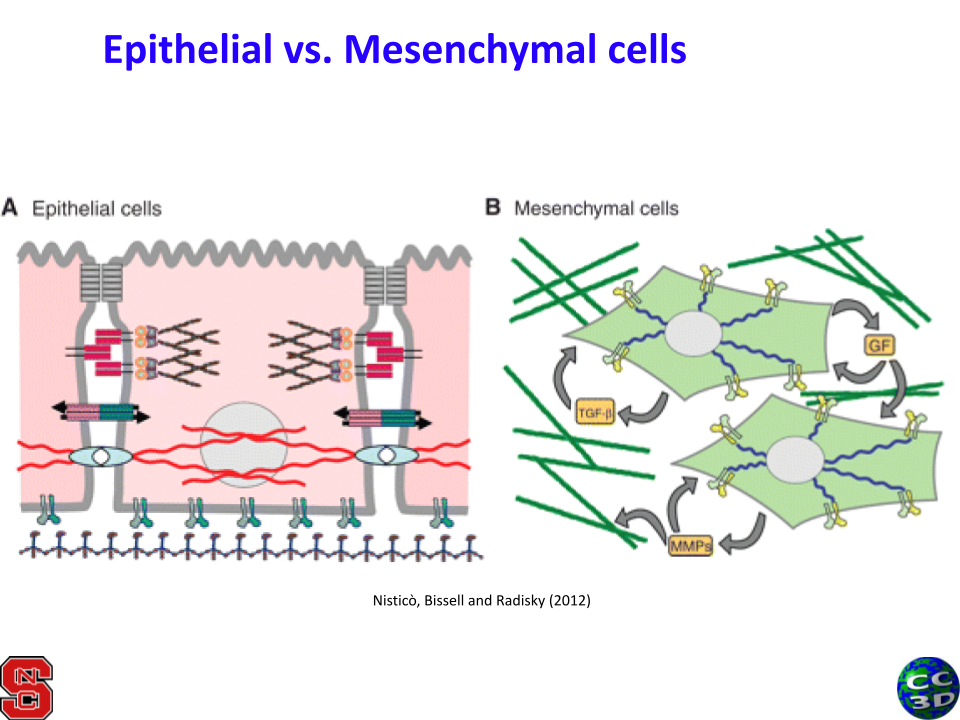Surface and Cell Contact
By controlling a cell’s surface, you can adjust the amount of perimeter it exposes to neighbors or the Medium. We recommend to always add the Contact plugin when creating a new simulation.
Properties
cell.targetSurface: the “goal” surface that a cell tries to reshape itself to whenever possible.
For roughly square or blob-shaped cells, targetSurface would be 4*sqrt(targetVolume).
cell.lambdaSurface: the strength of the surface constraint; that is, how quickly a cell will reshape itself to meet its targetSurface.
How to Detect Contact
Single Contact Event
At every time step, you should check each cell’s neighbors, then mark a dictionary property
to prevent the event from happening again for the same cell.
CC3D is not event-driven, so code to handle contact events should go in the step function.
Here is how to trigger an action when two cells collide.
def start(self):
#Add the `touching_macrophage_cell` attribute to every cell.
for cell in self.cell_list:
cell.dict['touching_macrophage_cell'] = False
def step(self, mcs):
"""
Check every bacteria to see if it is touching a macrophage.
If it is, and it has never touched a macrophage, then set the property to True.
"""
for cell in self.cell_list_by_type(self.BACTERIA):
for neighbor, common_surface_area in self.get_cell_neighbor_data_list(cell):
if neighbor: #Ensure we are not looking at the Medium
if neighbor.type == self.MACROPHAGE:
if cell.dict['touching_macrophage_cell'] == False:
cell.dict['touching_macrophage_cell'] = True
print("Contact happened!")
Periodic Contact Events
Notice that this interaction can only happen once.
If you want contact events to happen periodically, then you should limit how often the event triggers.
The below code shows how to trigger a contact event every 100 MCS.
Essentially, we check the previous time stamp of a contact event, last_cell_touch_time,
to see if it was at least 100 MCS in the past.
def start(self):
#Set the property to -100 so that the interaction can still happen on MCS=0.
for cell in self.cell_list:
cell.dict['last_cell_touch_time'] = -100
def step(self, mcs):
#...
if neighbor.type == self.MACROPHAGE:
if cell.dict['last_cell_touch_time'] - mcs >= 100:
print("Contact happened!")
cell.dict['last_cell_touch_time'] = mcs
#From here, you could change the cell's type or kill the cell
#if you wish to stop future interactions.
Using Contact to Transmit Cell Signals
Cells that need to maintain contact for an extended period would use similar code. For example, a CD4 T cell receptor requires time for an interaction with an antigen-presenting cell (Also called the MHC class II and TCR cell-cell interaction).
def start(self):
#Now -1 is a placeholder value to show that there
for cell in self.cell_list:
cell.dict['signal_received'] = 0
def step(self, mcs):
for cell in self.cell_list_by_type(self.CD4_T_CELL):
for neighbor, common_surface_area in self.get_cell_neighbor_data_list(cell):
if neighbor and neighbor.type == self.AP_CELL:
if cell.dict['signal_received'] < 50:
cell.dict['signal_received'] += 1
elif cell.dict['signal_received'] == 50:
print("Signal sufficient!")
Example: Epithelial-Mesenchymal Transition (EMT)
When a cell transitions from an epithelial cell to a mesenchymal cell, it is a hallmark of cancer. The cell loses its orderly, cube-like shape from its epithelial phenotype to a mesenchymal cell that has increased migrational capacity. The mesenchymal cell may be elongated and fragment away from its neighbors to prepare for intravasation.

Download the sample code here, then watch the video from the latest workshop to follow along:

- Key Takeaways:
Increasing contact energy between cells of the same type will move the cells apart
Decreasing contact energy between the mesenchymal cell and the medium will also help those cells move apart
Very high or low contact energy may cause cells to tear apart